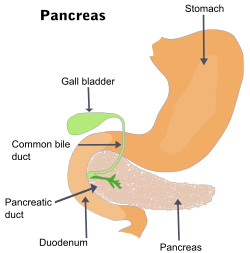Pancreatic duct
| Pancreatic duct | |
|---|---|
 The pancreatic duct | |
 | |
| Details | |
| Precursor | Pancreatic bud |
| Identifiers | |
| Latin | ductus pancreaticus |
| MeSH | D010183 |
| TA98 | A05.9.01.015 |
| TA2 | 3129 |
| FMA | 10419 |
| Anatomical terminology | |
18. Small intestine: 19. Duodenum, 20. Jejunum
21–22. Right and left kidneys.
The front border of the liver has been lifted up (brown arrow).[1]
The pancreatic duct or duct of Wirsung (also, the major pancreatic duct due to the existence of an accessory pancreatic duct) is a duct joining the pancreas to the common bile duct. This supplies it with pancreatic juice from the exocrine pancreas, which aids in digestion.
Structure
The pancreatic duct joins the common bile duct just prior to the ampulla of Vater, after which both ducts perforate the medial side of the second portion of the duodenum at the major duodenal papilla. There are many anatomical variants reported, but these are quite rare.[2]
Accessory pancreatic duct
Most people have just one pancreatic duct. However, some have an additional accessory pancreatic duct, also called the Duct of Santorini. An accessory pancreatic duct can be functional or non-functional.[3][4] It may open separately into the second part of the duodenum,[3][4] which is dorsal, and usually (in 70% of people) drains into the duodenum via the minor duodenal papilla. In the other 30% of people, it drains into the main pancreatic duct, which drains into the duodenum via the major duodenal papilla. The main pancreatic duct and the accessory duct both eventually—either directly or indirectly—connect to the second part ('D2', the vertical segment) of the duodenum.
It is named for Giovanni Domenico Santorini.[5][6]
-
Formation of an accessory pancreatic duct
Clinical significance
Compression, obstruction or inflammation of the pancreatic duct may lead to
Pancreatic ductal carcinoma is a common form of pancreatic cancer.
History
The pancreatic duct is also called the duct of Wirsung.
Additional images
-
biliary tree.
-
Accessory digestive system.
-
Interior of the descending portion of the duodenum, showing bile papilla.
-
Pancreas of a human embryo of five weeks.
-
Pancreas of a human embryo at end of sixth week.
-
Pancreatic duct Deep dissection.Anterior view.
-
Ultrasonography of a dilated pancreatic duct (in this case 9mm) due to pancreatic cancer.
References
- ISBN 978-0-8089-2371-8.
- S2CID 6917153.
- ^ a b Moore KL, Dalley AF. 2006. Clinically Oriented Anatomy. 5th Ed. Lippincott Williams & Wilkins. p 287.
- ^ a b 1. Mchonde GJ, Gesase AP. Termination pattern of main and accessory pancreatic ducts among Tanzanians. Anatomy Journal of Africa. 2014; 3(1):223–227.
- Who Named It?
- ^ G. D. Santorini. Observationes anatomicae. Venetiis, apus J. B. Recurti, 1724
- ^ "American Gastroenterological Association". Archived from the original on 2008-06-07. Retrieved 2010-03-15.
- ISBN 0-7817-3639-0.
- PMID 17461473.
- S2CID 20674576.
- S2CID 21851681.
- Who Named It?








